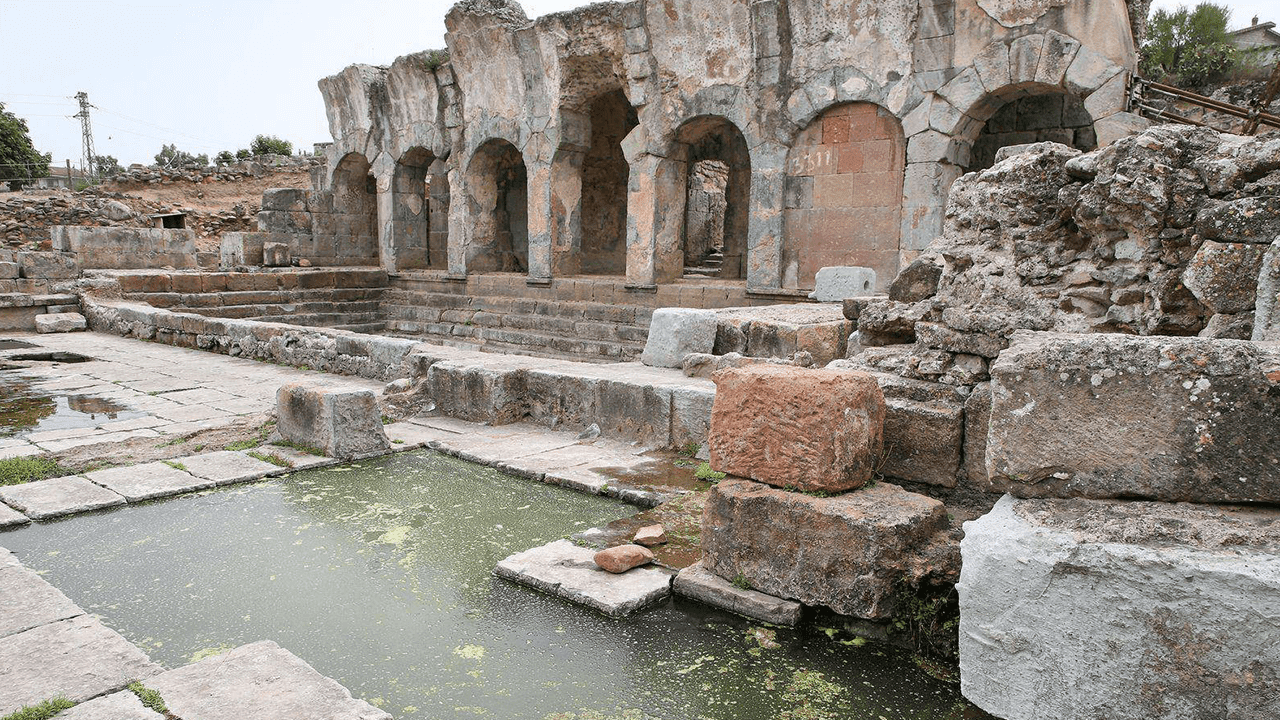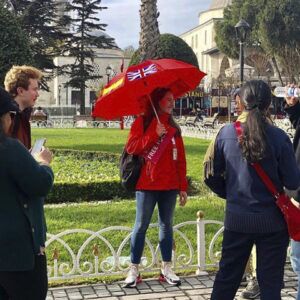Roman Baths at Ephesus: A Treasure of Ancient Roman Culture
The Roman baths in Ephesus represent an essential aspect of daily life in this ancient city. In addition to their hygienic function, these baths served as spaces for socialization and recreation, where citizens discussed important matters and enjoyed a relaxing environment. Each of these bath complexes featured impressive architectural characteristics and advanced heating systems.
The Baths of Varius
Located to the east of the Basilica, the Baths of Varius date back to the 2nd century AD and are notable for their construction from blocks of carved marble. This complex included the three classic sections of Roman baths: the frigidarium (cold water), the tepidarium (warm water), and the caldarium (hot water). The 40-meter-long mosaic hallway was added in the 5th century, adding an artistic detail to this structure. Excavations in this area are still ongoing, leaving room for future discoveries.
Architecture and Layout of the Baths
The Baths of Varius are an outstanding example of Roman engineering and architecture. Their sections, differentiated by water temperature, created a progressive relaxation system, allowing users to alternate between cold and hot environments for enjoyment and health benefits.
The Scholastica Baths
Originally built in the 1st century and restored in the 4th century by a Christian woman named Scholastica, the Scholastica Baths are another example of Ephesus’ advanced bath facilities. To the left of the east entrance, a headless statue of Scholastica represents her legacy in restoring these baths.
Structure and Spaces in the Scholastica Baths
The original structure of the baths had three floors, although the upper two have collapsed over time. Entering from Curetes Street, the main entrance, visitors first find the dressing room (apodyterium) with ten cubicles, followed by the frigidarium (cold room) with a pool. Next is the tepidarium (warm room) and finally the caldarium (hot room) with an advanced heating system. The second floor was used for massages and scrubs, making these baths a place for both hygiene and personal care.
Social Importance of the Baths
Roman baths served not only for cleanliness but also as gathering places for socialization. Citizens discussed important topics concerning city life, making these baths key spaces for social interaction. This custom continued during the Byzantine period and was later perfected by the Ottomans, who brought baths to their highest expression in Anatolia.
The Baths of Constantine or Harbor Baths
Located at the entrance to the harbor along the Arcadian Way, the Harbor Baths, also known as the “Baths of Constantine,” were built in the 2nd century AD and repaired under Emperor Constantine. This impressive building, 160 meters wide, 170 meters long, and 28 meters high, was one of the largest complexes in Ephesus.
A Monument of Imperial Roman Architecture
With its imposing size and strategic location, the Baths of Constantine served as a meeting point at the harbor, allowing visitors and citizens to enjoy relaxing baths before or after their commercial activities. The grandeur of this building reflects the splendor of imperial Roman architecture and its importance in Ephesus’ daily life.
The East Gymnasium Baths
Located north of the Magnesia Gate, the East Gymnasium Baths combine a gymnasium and baths, built around the 2nd century AD. This space included large central bathing halls and vaulted corridors on three sides for exercise, games, and conversation.
The Connection Between Exercise and Hygiene
The East Gymnasium Baths were not only a place for bathing but also for physical activity and exercise. The Romans understood the importance of combining physical activity with personal hygiene, making this gymnasium a complete space for wellness and health.
Tips for Visiting the Roman Baths in Ephesus
- Plan your time: The baths of Ephesus are extensive and detailed, so it is recommended to set aside enough time to explore each of them thoroughly.
- Comfortable footwear: Since they are ruins, the terrain can be uneven. It is advisable to wear suitable shoes for walking.
- Respect the site: As a historical site, visitors are asked to respect the ruins and avoid touching or damaging them.
Conclusion
The Roman baths of Ephesus offer a fascinating glimpse into daily life in ancient Rome. From the Baths of Varius to the Baths of Constantine, each of these complexes represents an important facet of Roman culture regarding hygiene, socialization, and architecture. These historical sites continue to stand as witnesses to the grandeur of Ephesus and its rich cultural heritage, providing visitors with a unique experience of the ancient world.



3 thoughts on “Roman Baths at Ephesus”
★★★★★
Learning about and visiting ‘Roman Baths at Ephesus’ was both fun and educational. Everyone should experience this!
★★★★★
Visiting ‘Roman Baths at Ephesus’ was an extraordinary experience, offering insights and enjoyment like no other. Highly recommended!
★★★★★
I was blown away by everything ‘Roman Baths at Ephesus’ has to offer. Definitely a place to return to in the future.